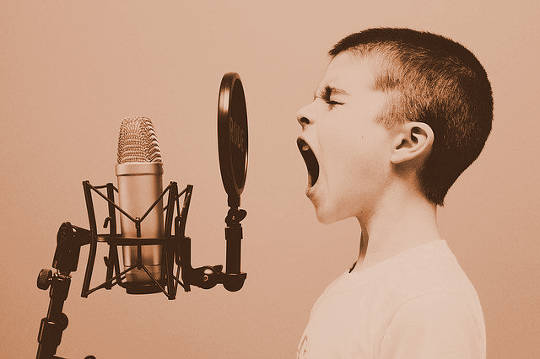
Image by Free-Photos
There will come a time when a diseased condition of the soul life
will not be described as it is today by the psychologists,
but it will be spoken of in musical terms,
as one would speak, for instance, of a piano that was out of tune.
-- Rudolph Steiner
Sound and the continuation of life go hand-in-hand. Many living organisms communicate so richly through sound that it is hard to imagine their survival without it. In many species the life-sustaining processes of mating and reproduction rely solidly on systems of calls -- bird song and the songs of whales are examples -- that are bewilderingly complex, and some of which are decidedly musical.
In humans, the physical body reflects the sounds we perceive, down to the biochemical level. So sensitive are we to sound that noise pollution has been called the most common modern health hazard. High levels of unpleasant sounds cause blood vessels to constrict; increase the blood pressure, pulse, and respiratory rates; release extra fats into the bloodstream; and cause the blood's magnesium level to fall.
Get The Latest By Email
Noxious sounds are a particular hazard in the modern hospital, where there can be a steady barrage of sonic unpleasantness. Patients recovering from heart attacks in modern coronary care units are particularly susceptible to unpleasant sounds; noise pollution in these settings can affect survival and recovery.
Dissonant or Inharmonic Sounds
People are disturbed not only by loud sounds but also by those that are dissonant or inharmonic. They can also be disturbed by silence. If healthy persons are confined to bed and exposed to soft but varied harmonic sounds, they perceive this stimulus as more restful than subjects who are in a completely quiet environment.
But sounds can mean something to us that is not adequately explained by an analysis of the physical changes they cause. Some are tied to levels of reality beyond the physical processes of mating, reproduction, species survival, and bodily chemistry. Larry Ephron of Berkeley, California has suggested that certain sounds are connected to the recognition of transcendent and spiritual realities. The repetition of these sounds conveys something that can't be analyzed in terms of decibels or cycles per second. As he says,
"It suddenly came to me . . . that the word for the spirit of the universe or whatever you want to call 'It' has the sound ''aahhh'' in many languages. To wit: God, Jah, Ra, Allah, Brahma, Atman, Yahweh, Ram, Baal, Ahura Mazda (I'm using the Thesaurus), Og, Hachiman, Mab, nagual, mane, waken, huaca... I think it's because the 'aahhh' sound relaxes the jaw and throat, assisting us in letting go and giving in to what is."
Spiritual Traditions Prescribe Sounds and Silence
For millennia, many great spiritual traditions have prescribed the repetition of certain sounds that are known to promote the experience of transcendent realities. The ritualistic use of specific chants, prayers, incantations, affirmations, and holy words is truly worldwide. Are these sounds affecting our spiritual health, just as other sounds can affect our physical health? Could certain sounds affect both our physical and spiritual well-being -- a kind of sonic wonder drug that works on all the dimensions of human experience? There is evidence for this possibility.
Certain meditation practices that emphasize the repetitious chanting of special sounds, or mantras, are associated with demonstrable health benefits. For example, Transcendental Meditation (TM), which employs mantras, has been helpful in treating serious medical problems such as irregular heart rhythms, and evidence suggests that the prolonged use of TM can reverse many aspects of the aging process. Statistics also show that the rate of hospital admissions and the overall health costs of TM practitioners are lower than that of non-meditators.
Cultivation of silence has also been shown to have positive health benefits, In one study, when men with high blood cholesterol levels learned to quiet their mental activity for twenty minutes twice a day while simply sitting in a chair, their cholesterol levels fell by one-third.
Our Musical DNA
How are these things possible? One reason may be that the body itself is intrinsically musical, right down to the DNA that makes up our genes. The idea that DNA and music might be connected comes from the work of Dr. Susumu Ohno, a geneticist at the Beckman Research Institute of the City of Hope in Duarte, California. In order to understand Dr. Ohno's insights, recall that every organism's genes are composed of strands of DNA, which in turn are made up of four so-called nucleotides containing the bases adenine, guanine, cytosine, and thymine, arranged in sequences that are unique for each species.
In an imaginative leap, Dr. Ohno assigned musical notes to these substances -- do to cytosine (C), re and mi to adenine (A), fa and sol to guanine (G), la and ti to thymine (T). Then Dr. Ohno chose a particular key, timing, and duration of each note. The result was a melodic composition that was finally fleshed out with harmonies by his wife, Midori, a musician. When completely transcribed, the scores were then performed by professional musicians on instruments such as the piano or organ, violin, and viola.
Dr. Ohno has notated over fifteen "songs of the DNA" of a variety of living organisms during the past two years. He finds that the more evolved an organism is, the more complicated its music. For example, the DNA of a single-cell protozoan translates into a simple four note repetition. But the music transcribed from human DNA -- e.g., from the body's receptor site for insulin -- is much more complex. To listeners knowledgeable about classical music, these DNA-based compositions have been taken variously for the music of Bach, Brahms, Chopin, and other great composers. These melodies are majestic and inspiring.
Many persons hearing them for the first time are moved to tears; they cannot believe that their bodies, which they believed to be mere collections of chemicals, contain such uplifting, inspiring harmonies -- that they are musical.
Not only is it possible to make music starting with DNA, one can do the reverse: one can start with great pieces of music, assign nucleotides to the notes, and end up with a specific type of DNA. When a Chopin piece was transcribed into a chemical notation, sections of the resulting formula were the DNA of a human cancer gene. It seems that even cancers have their own music!
If connecting DNA and music seems fanciful, we should recall that there is no reason in principle why DNA has to be described in the familiar alphabetical symbols of organic chemistry -- C for carbon, N for nitrogen, O for oxygen, H for hydrogen, etc. It could be described using many symbols, even musical notes. It is the pattern that's the point.
Many great artists, writers, and musicians have heard messages in nature, some of them musical. When Mozart heard a complex, lengthy piece of music fully formed, where was it coming from? When Hesse said in the prologue to Demian that he had learned to listen to the messages his blood whispers to him, what was he actually hearing? How do we explain synesthetes, those individuals in whom multiple instead of single senses operate simultaneously, people who smell sounds and see musical tones? Where is this information coming from? Are they in touch with some music encoded in their bodies?
Concert pianist Lorin Hollander has described the rich visual imagery he has experienced all his life on playing the works of the great composers. These images, he states, often take the form of highly complex geometric designs. His experience affirms Pythagoras's assertion in the fifth century B.C.: "There is geometry in the humming of the strings. There is music in the spacings of the spheres." Hollander was astonished when he later discovered that these forms, which he had visualized since childhood, were practically identical to many of the beautiful tile designs on Islamic mosques scattered throughout the Middle East. The pentagonal and hexagonal shapes that are repeated in these designs show striking similarity to the way DNA is represented in two-dimensional chemical notation. In the body, the nucleotides that make up DNA are not, of course, two-dimensional figures; that is only the way we draw them "on paper".
But that may be the way they display themselves to the imagination -- whether to Hollander, whose music calls them forth, to molecular biologists, or to the great artists who embellished the mosques of Islam with these images.
If we were imaginative enough to think musically as well as alphabetically, this just might permit us to hear the music of the body. This perspective could provide us with nobler visions of the body.
Reprinted with permission from the publisher, Quest Books,
The Theosophical Publishing House. ©1992
http://www.theosophical.org.
Article Source
 Music and Miracles
Music and Miracles
by Don Campbell.
Personal testimony from researchers, healers, and musicians about how music can change lives.
For more info or to order this book
About The Author
 Larry Dossey is a contributing author to the book Music and Miracles by Don Campbell. Dr. Dossey is the author of numerous books and articles. He has lectured all over the world, including major medical schools and hospitals in the United States. Before his book Healing Words: The Power of Prayer and the Practice of Medicine was published in 1993, only three U.S. medical schools had courses devoted to exploring the role of religious practice and prayer in health; currently, nearly fifty medical schools have instituted such courses, many of which utilize Dr. Dossey's works as textbooks. In his 1989 book Recovering the Soul, he introduced the concept of "nonlocal mind" -- mind unconfined to the brain and body, mind spread infinitely throughout space and time. His latest book is Reinventing Medicine : Beyond Mind-Body to a New Era of Healing.
Larry Dossey is a contributing author to the book Music and Miracles by Don Campbell. Dr. Dossey is the author of numerous books and articles. He has lectured all over the world, including major medical schools and hospitals in the United States. Before his book Healing Words: The Power of Prayer and the Practice of Medicine was published in 1993, only three U.S. medical schools had courses devoted to exploring the role of religious practice and prayer in health; currently, nearly fifty medical schools have instituted such courses, many of which utilize Dr. Dossey's works as textbooks. In his 1989 book Recovering the Soul, he introduced the concept of "nonlocal mind" -- mind unconfined to the brain and body, mind spread infinitely throughout space and time. His latest book is Reinventing Medicine : Beyond Mind-Body to a New Era of Healing.







